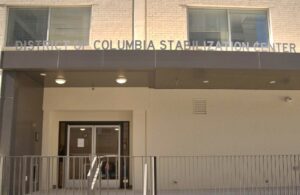D.C. is in the middle of a potentially fatal housing crisis. For the thousands of city residents experiencing homelessness or facing imminent eviction, after-dark temperatures are dangerous. Night temperatures can drop well below freezing, especially with wind chill. The District must immediately halt scheduled homeless encampment evictions, redouble its efforts to properly execute its hypothermia plan, and accelerate investments in affordable housing over the long term.
The D.C. government is one of only three jurisdictions in the entire United States to legally require itself to provide shelter to all city residents during hypothermia conditions. The city’s Interagency Council on Homelessness (ICH) publishes an annual plan outlining how D.C. will connect unhoused people with emergency shelter in case of freezing temperatures. Yet, in execution, the city’s plans have fallen short, costing lives in the process.
On Dec. 21, D.C. residents held a vigil for the 69 people who died in 2021 while experiencing homelessness in the District. In 2020, that number was 180. Seven people died of hypothermia or cold exposure last winter, according to the Interagency Council on Homelessness’ most recent report—more than triple the number of deaths to occur in a single winter since at least 2015. Homelessness is deadly.
This year’s plan recommended the Department of Human Services (DHS) identify at least 1,500 beds for unhoused men and 625 for women, a 125-bed increase from the previous year. This attempts to account for a projected increase in displacement resulting from housing evictions, which are up this year after the city began rolling back its pandemic-related moratorium. That said, DHS should not assume this projection will be sufficient; circumstances are likely to become more dire. Last year’s ICH plan also called for more beds, yet peak usage exceeded that initial recommendation and overflow beds had to be secured.
The only long-term solution to hypothermia in D.C. is ending homelessness altogether. In the short term, however, the city must stop evicting residents experiencing homelessness from their encampment communities. Though maintaining tent clusters stops short of actually supplying residents with an apartment or a comparably autonomous housing unit, encampments, as a means of experiencing homelessness, are among the safer options. For unhoused residents averse to using traditional congregate shelters—where occupants could be more exposed to COVID-19 or sometimes suffer abuse—a tent can provide more than protection against cold weather. In an encampment community, residents can be assured that they would have nearby help should they need immediate medical assistance. Forcibly destroying these communities corrodes trust between city workers and unhoused residents, all while eliminating a critical shelter option for unhoused people.
In August, Mayor Bowser announced a pilot program to clear five large encampments in the city, citing the public health and safety risks encampments pose to residents of both the encampments themselves and of neighboring areas. The program, now formally known as Coordinated Assistance and Resources for Encampments (CARE), directs outreach workers to connect with encampment residents and expedite their access to affordable housing and permanent housing subsidies. Individuals staying in encampments would then be relocated and prohibited from returning, after which the encampments would be cleared according to an eviction timeline.
Advocates for those experiencing homelessness have, however, fiercely criticized the program for evicting encampment residents before matching them with adequate housing and health resources.
The city government has recently cleared long-standing encampments in NoMa and Truxton. In a D.C. Council hearing, Deputy Mayor for Health and Human Services Wayne Turnage lauded the “89 percent success rate” for the clearings. Those numbers, however, do not and should not represent success: 11 out of the 45 encampment residents are still in the process of getting housed after being evicted, and 5 other residents remain unhoused as a result of the CARE program’s shortcomings.
Clearing encampments greatly disrupts and threatens the safety of their residents, many of whom may lose possessions in the process of relocating or face worse living conditions after vacating their encampments. In the clearing of the NoMa encampment, an unhoused resident was hit by a bulldozer when encampment clearing officials lifted the resident’s tent with the individual still inside. The individual sustained no visible injury, but “received additional medical attention,” according to a statement from Deputy Mayor Turnage. The use of such unnecessarily heavy machinery itself highlights how CARE’s callous nature serves more as a threat of violence to encampment residents than anything else.
The process of finding temporary shelter places unhoused people in extreme vulnerability. Many prefer staying in their encampments to waiting for more permanent housing, a process which often involves long wait times and extreme confusion. Evicted residents of the Truxton encampment, for example, suffered from the D.C. government’s complete lack of communication, being left in the dark about where they and their belongings would be moved. Not only do residents deserve a clear line of communication, but the use of a time-sensitive, blanket eviction process deprives residents of any agency in housing choice.
The District’s severe lack of affordable housing compounds eviction challenges. During the pandemic, the number of people experiencing chronic homelessness rose by 20 percent at the same time as rapid gentrification and an influx of new residents placed increased pressure on D.C.’s low-income residents. City policies have not kept up.
The city has not invested sufficiently in repairing existing public housing projects in desperate need of maintenance: of the estimated $2.2 billion over the next 17 years needed to properly repair existing units, only $25 million has been allocated. To be sure, in July, Bowser’s administration invested $400 million over two years through the Housing Production Trust Fund, which aims to build 462 new affordable housing units and preserve an existing 175 units. But the Urban Institute, a D.C.-based think tank, projected that the city would need to produce 364,000 new units of housing to account for population growth by 2030. Moreover, most affordable housing being built will not be completed within the next five years. In total, Bowser’s policy provides just 36,000 units over the next 5 years, of which only 12,000 will be affordable. Thus, Bowser’s policies are neither sufficiently scaled nor targeted enough to properly alleviate the needs of D.C.s lowest-income residents.
And D.C. policy ensures that the existing stock of housing remains unaffordable for many. Bowser’s 2022 budget includes no increased funding for Targeted Housing Vouchers crucial for residents exiting the Rapid Re-Housing program: 83 percent of them cannot afford housing without government assistance. Most troublingly, the budget also cuts funding for the Emergency Rental Assistance Program (ERAP), which supports residents earning less than 40 percent of median income in paying their overdue rent.
In the absence of policy reform, rapid gentrification will continue to harm D.C.’s minority and lower-income communities. New D.C. government studies have shown that historically Black communities have become increasingly white, and that zoning policy and rising land costs severely limit the availability of affordable housing in Wards 2 and 3, historically Black neighborhoods that white gentrification encroaches upon. Over the past few years, the wages of renters in D.C. in particular have stayed relatively stagnant while rents consistently rose; over a half of D.C. renters spend more than a third of their income on rent, and a third routinely spend more than half of their income.
Unlike in other highly gentrified cities, gentrification in D.C. has forced low income residents to leave gentrifying areas, thus shifting local demographics. D.C., despite being nominally overtaken by cities such as San Francisco and Boston in raw gentrification rates, arguably faces worse demographic consequences: over the past 20 years, while average incomes have increased, the city’s Black population has decreased from 60 percent in 2000 to around 46 percent today.
The strict timeline for the CARE program’s encampment clearings, the careless manner in which they are conducted, and the failure of the D.C. budget and its programs to properly cover the needs of the lowest income residents all cast doubt on the city government’s motives.
Given that the encampment at NoMa, which received public complaints from the area’s residents, was the first to be cleared this fall, it’s worth asking: does CARE really serve the unhoused, or is it simply a means of forcing them out of sight—and thereby out of mind—to appease the city’s more privileged residents?
To even begin to address these issues in a way that brings about real change for the District’s unhoused community, concerned D.C. residents need to hold the city’s elected officials accountable. While government action alone is not the cure-all for D.C.’s homelessness crisis, those in power can take immediate action to help those facing housing insecurity.
The voice and vote of this city’s residents matter. The upcoming D.C. mayoral election will bring the city’s budgetary priorities and the efficacy of programs like CARE to the forefront of conversations in the District, especially because many of the candidates’ platforms aim to address systemic injustice and inequities—wrongs exemplified by D.C.’s housing crisis. For those who can vote in the District, civic participation in the upcoming election is one of the most direct ways to ensure elected officials in office are prioritizing D.C.’s unhoused population.
Anyone can call into and speak at public hearings for D.C. Council committees that deal with these budgetary, eviction, and housing concerns. The Committee on Housing and Executive Administration and the Committee on Human Services in particular cooperate on legislation addressing and oversight over homelessness in the city, and their scheduled hearings can be accessed online. You do not have to be a registered voter in the District or even a long-term resident. There are members of D.C.’s government—council members like Robert White (At-Large), Brianne Nadeau (Ward 1), Trayon White (Ward 8)—who care, who have been trying to bring attention to these issues. Students can speak up and let the city know that we won’t stand for the injustice of displacement.
While government programs should be taking steps to undergo necessary reform, mutual aid networks can usefully assist the unhoused community when government fails to help. Georgetown students with the resources to do so can donate to non-profit organizations such as Coalition for the Homeless, where a donation of just $48 covers a night of shelter for an individual in need of housing.
To be sure, none of these solutions will completely solve the problems of homelessness, and no one solution will meet the specific needs of every unhoused individual. Local and national economic structures must change to prevent people from becoming unhoused in the first place. Nevertheless, we as students can still do our part to assist D.C.’s unhoused community. As the temperatures fall, we need to act with urgency to ensure our fellow neighbors are safe, housed, and protected this winter—and every day, season, and year after.





